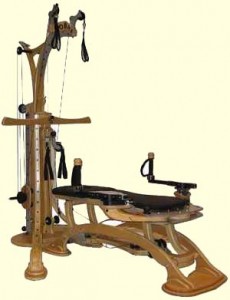by Jan Dunn, MS

Summer is almost here, and if you’re still a student, you’ll be out soon for summer break — and if you’re a professional dancer, you might have at least some time off over the coming months (hopefully!). In recent articles, we’ve been talking about the value of outside-of-class conditioning for dancers of all ages, to help your body stay in great shape for a long, healthy career. Summer is a good time to investigate different forms of outside conditioning that are beneficial for dancers (if you aren’t already doing some!).
The last article I posted on this topic was about Pilates –this time we’ll talk about GYROTONIC® and GYROKINESIS® (G & G, we will call them, when talked about together), exercise forms which are not as well known / widespread as Pilates, but one which many dancers enjoy.
Juliu Horvath, the creator / founder of the system, is a Hungarian “man for all seasons” – a former professional ballet dancer, yogi, and wood sculptor, now in his 60’s. Like many people who went on to develop unique methods to address concerns about the body, Horvath suffered career-ending injuries while performing as a principal dancer with the Houston Ballet. He moved to the Virgin Islands to recover, and began an extensive study and practice of yoga. His experience and research led to developing the G & G system, He states:
“I discovered Kundalini energy through my pain and agony, and somehow that awakened me. Being awakened energetically means that you can read the movement when it is not a movement yet. You are like a little child who is totally unconscious and not prepared to make movement happen. Children move because something moves them from within.”
The G & G movement system gently works the joints and muscles of the body, using key principles which are found in many forms of movement, such as yoga, tai-chi, gymnastics, swimming – and dance. It is an undulating, rhythmic, circular movement form, which is one of the appeals to dancers.
Horvath’s aim is to take the body “beyond its current limitations”. The exercises strengthen, lengthen, and stretch muscles, stimulating the connective tissue around the joints – improving balance, flexibility, coordination, and strength.
The system has two components, mentioned earlier:
GYROKINESIS® (originally called “Yoga for Dancers”), which is without using equipment, and done seated on a stool. This work forms the core of the system, using 7 natural spinal movements:
-forward (“flexion” in anatomical terms)
-backward (“hyperextension”)
–left & right side flexion (“lateral flexion” – i.e,bending to the side)
-left twist (“rotation”)
-right twist
-circular
Gyrokinesis has been described (by both those doing and those watching) as fluid, continuous, and harmonious.
GYROTONIC® is the equipment aspect of the system. Horvath designed all of the equipment after the basic exercises of the Gyrokinesis form had already evolved. He was looking for a way the user would be able to use equipment (i.e, with resistance) to perform the movement continually, without interruption — in the circular, harmonious shapes that he had developed and envisioned.

There are several pieces of equipment used, the primary one being The Tower. This piece has evolved considerably in the last 20 years, and is a pulley tower combination – a curvy wood structure with pulleys and weights. It is designed to increase spinal movement (called “articulation” in anatomical terms) and three-dimensional body awareness.
In addition to The Tower, there are several other specialized pieces of equipment:
-The Gyrotoner, which is especially helpful for shoulder and arm rehab.
-The Jumping Stretch Board, designed to strengthen and stretch the torso, and which is especially useful for lateral (sideways) movements of the legs.
-The Ladder, which increases proprioception (this is our physical sense which tells us where we are in space — a crucial ability for dancers — and one which is immediately negatively affected with any injury). It also enhances stretching.
-The Leg Extension Unit is used for knee and ankle / foot rehab.
The G & G system is used not only in the dance world, but also in therapeutic and sports environments. It is usually found primarily in larger cities, but to know if there is a studio in your area, you can go to the Gyrotonic Health Network website, and enter your zip code.
The next article on conditioning for dancers will look at the Franklin Method, a science-based movement education system using imagery, touch, and movement, which is increasingly being taught in dance environments world-wide.
We will also be bringing in our first guest author, Emma Redding, PhD, current President of IADMS (International Association for Dance Medicine and Science) and Head of Dance Science at Trinity Laban Conservatoire of Dance in London, England. Emma will be sharing her knowledge and expertise on the importance of outside aerobic conditioning for dancers.
Editor Jan Dunn is a dance medicine specialist currently based on the island of Kauai, Hawaii, where she is affiliated with Pilates Kauai. She is also a Pilates rehabilitation specialist and Franklin Educator.
Originally a dancer / choreographer, she became university dance faculty, most recently as Adjunct Faculty, University of Colorado Dept. of Theatre and Dance. Her 28 year background in dance medicine includes 23 years with the International Association of Dance Medicine and Science (IADMS) – as Board member / President / Executive Director – founding Denver Dance Medicine Associates, and establishing two university Dance Wellness Programs.
Jan served as organizer and Co-Chair, International Dance Medicine Conference, Taiwan 2004, and was founding chair of the National Dance Association’s (USA) Committee on Dance Science and Medicine, 1989-1993. She originated The Dance Medicine/Science Resource Guide; and was co-founder of the Journal of Dance Medicine & Science. She has taught dance medicine, Pilates, and Franklin workshops for medical / dance and academic institutions in the USA / Europe / Middle East / and Asia, authored numerous articles in the field, and presented at many national and international conferences.





Thank you for sharing! Love your article.